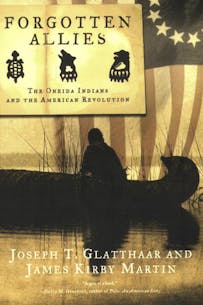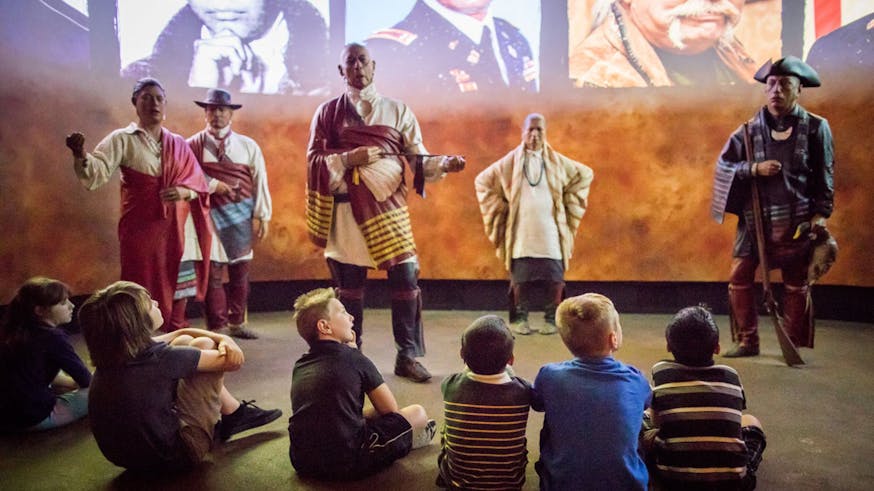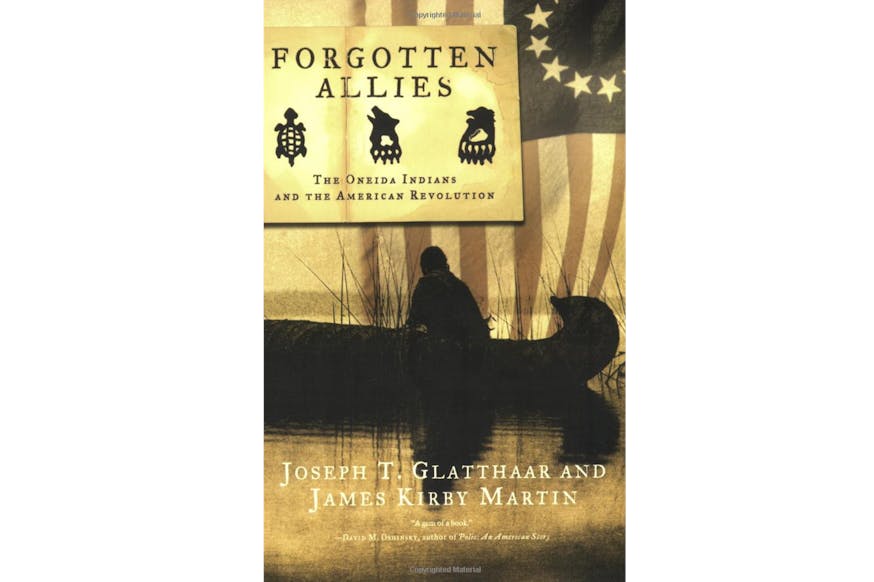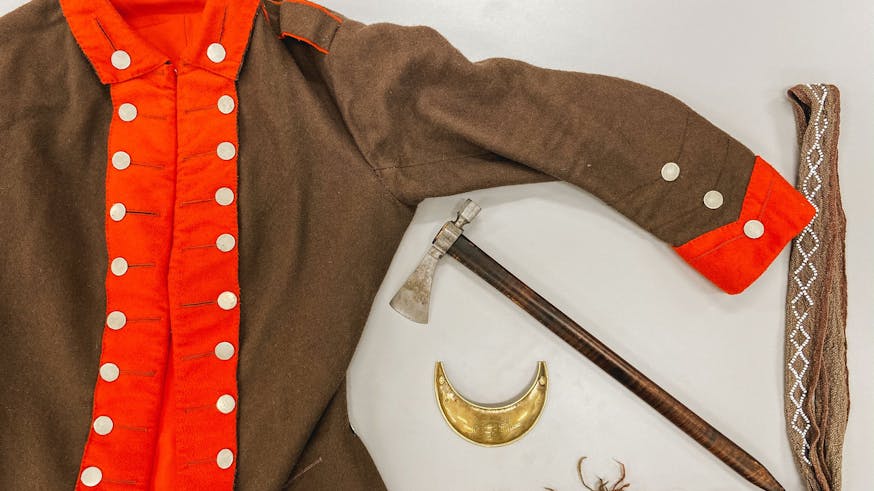Read the Revolution
Forgotten Allies
November 10, 2021
Purchase the book from Macmillan Publishers.
When the Marquis de Lafayette returned to tour the United States in 1825, he surprised his hosts in Utica, New York, with a request to visit with their Mohawk Valley neighbors: the Oneida veterans. In contrast, delegates of the Continental Congress had pledged to remember their Native American allies less than 50 years earlier, on Dec. 3, 1777:
We have experienced your love, strong as the oak, and your fidelity, unchangeable as truth… While the sun and moon continue to give light to the world, we shall love and respect you. As our trusty friends, we shall protect you; and shall at all times consider your welfare as our own.Continental Congress, Dec. 3, 1777
In Forgotten Allies: Oneida Indians and the American Revolution, military historians Joseph Glatthaar and James Kirby Martin present the action-packed story of Oneida contributions and sacrifices during the Revolutionary War, honoring centuries of oral history and written for a broad audience. In this book — a staff favorite that inspired the conversation recreated in our Oneida Indian Nation Theater and the film People of the Standing Stone — the authors present perspectives from a powerful couple: Revolutionary War veterans Tyonajanegen (Two Kettles Together) and Chief Warrior Han Yerry Tweahangarahken (He Who Takes Up the Snow Shoe).
Yerry, born to a Mohawk mother and a German father, considered himself an Oneida. He became chief warrior of that nation’s Wolf Clan and mustered support for the Revolutionary cause. After the Battle of Oriskany, he was part of the Oneida party that travelled to Valley Forge and dined with George Washington. In 1779, he was made a captain as one of several Oneida and Tuscarora warriors who received officers’ commissions from Congress. Before his death in 1794, Yerry represented his Oneida village in a boundary dispute with Congress. Two Kettles Together outlived her husband by almost 30 years. However, neither of these individuals were honored as veterans at the 100th anniversary of the Battle of Oriskany on August 6, 1877. Although 75,000 people gathered near where the Oneida village of Oriska once stood, the event’s speakers neglected to acknowledge the Oneidas who had fought beside American rebels and help them to win their independence.
Read an excerpt from Chapter 7: Defending the Oneida Homeland for an introduction to Two Kettles Together and Han Yerry as we remember their bravery during the Battle of Oriskany.
Excerpt
Chief Warrior Han Yerry had long since chosen the side he would favor should his fellow Oneidas enter the war. After the skirmishes at Lexington and Concord, he raised a band of Oneidas who were “friendly to the Americans in their struggle for liberty.” Initially, their purpose was to scout and defend the homeland. With St. Leger’s expeditionary force making its way along the water route from Fort Oswego in late July 1777, now literally trespassing on Oneida territory, Han Yerry and his followers felt the time was at hand to embrace the fight.
Born about 1724, somewhere in the Mohawk Valley, Han Yerry was likely the product of a mixed relationship, with a Mohawk mother and a father of German descent. He thought of himself as an Oneida, and the People of the Standing Stone concurred, as he later emerged as a chief warrior of the Wolf Clan. The Oneidas referred to him as Han Yerry Tewahangarahken, or “He Who Takes Up the Snow Show.” Many others, especially local whites, called him Han Yerry Doxtader, a reflection of his supposed German heritage.
Sometime in the 1750s, Han Yerry married an extraordinary woman named Tyonajanegen, or “Two Kettles Together.” The couple settled at Oriska, counting themselves among those who had founded that castle. Over the years, they had three sons and a daughter. Two Kettles Together and their elder sons, Jacob and Cornelius, by the mid-1770s in their mid- to late teens, also favored the rebel cause.
Few surpassed Han Yerry in reputation among the Oneidas. In young adulthood, he exhibited exceptional courage and coolness in combat. As the years passed, he lost some of his physical vigor but not his mental and emotional edge. In his fifties during the Revolution, he was remembered by one observer decades later as an “ordinary sized” fellow and “quite a gentleman in his demeanor.” An Oneida friend, Hendrick Smith, honored him when he said, “Hon Yerry was too old for the Service, yet used to go fearlessly into the fights.”
At Oriska, Han Yerry and his family prospered on an expansive farm, catering to travelers and people at nearby Fort Stanwix. By 1777, he and his family lived in a substantial frame house, had a barn, and owned fifteen horses, a half dozen cattle, sixty hogs, two sheep, six turkeys, and a hundred chickens. The family grew a variety of crops and owned an assortment of farm implements, including a wagon and a sleigh for winter travel. Two Kettles Together cooked meals in brass and copper kettles and served guests on pewter plates. Han Yerry had become one of the wealthiest of all Oneidas.
Although he had flourished economically under British rule, Han Yerry disliked the Crown. Like other Oriska residents, he resented Sir William Johnson and his government for their actions in negotiating the Treaty of Fort Stanwix during 1768. The superintendent had wanted an eastern section of Oneida territory, including lands that encompassed Fort Stanwix and Oriska, to be available for Crown development and future settlement. At first, the Oneidas refused to cede that section, but Sir William coerced them into acquiescence. The people of Oriska were furious that they now owed their continued presence there to the goodwill of the British government. Alienated from the Johnsons, Han Yerry and other Oriska inhabitants gravitated toward the rebellious Whigs. By 1777 the Oneidas at Oriska, including the emissary Henry Cornelius, Han Yerry’s brother Han Yost Thahoswagwat (“His Lip Followed Him”), Hendrick Smith, and Blatcop Tonyentagoyon (also called Platcoff, Henry Trathoop, and “Old Legs”), all prepared themselves to fight alongside Han Yerry against St. Leger’s force.
Sign Up
Get biweekly Read the Revolution featured excerpts right to your inbox.
[...]
As Fort Schuyler braced for the attack, the Oneidas caucused at Kanonwalohale, seeking to chart a unified course. None of the options was appealing. At this juncture, the prospect of swaying a majority of the Six Nations back toward nonalignment was nil. If the Oneidas remained neutral, they would have to endure the humiliation of an invasion of their homeland—a prospect that mortified the warriors. By doing so they would tacitly be admitting a lack of courage with regard to defending the sanctity of borders that their ancestors had established, which generations of forebears had protected, and where Oneida spirits now resided. Equally undesirable, by granting St. Leger the right of passage, they would alienate the rebels and place the People of the Standing Stone in jeopardy from retaliatory strikes.
Another alternative called for them to resist St. Leger’s force, even to the point of combat, a position Han Yerry and others advocated. This prospect reflected the will of most Oneidas, who leaned toward the rebel cause anyway. Further, they would be actively shaping their own destiny, rather than sitting by passively while others molded their future for them. If they challenged the British onslaught, however, the Oneidas would be forever abandoning their neutral course while placing themselves at odds with many of their confederacy brethren and converting their homeland into a battleground.
[…]
Without stating what was obvious, the Oneida Nation had altered in policy. No longer would neutrality encumber the warriors. Under the duress of an invasion, individual Oneidas could now freely choose their own course of action, which meant they could fight alongside the rebels with their leadership’s blessing.
[…]
About three hours into the struggle the skies opened up on the combatants, and passing thundershowers provided timely relief for the weary, causing an hour-long lull in the fighting. Visibility declined, and heavy rains moistened gunpowder, especially in flashpans, making muskets nearly impossible to fire. The break greatly aided the rebels, who caught their breath while regrouping and pairing up so they could more effectively ward off Iroquois tomahawk attacks. Herkimer was also able to organize the survivors into defensive circles for better protection.
Amid the noise of battle and stormy weather, Han Yerry represented the ideal of calmness. Mounted on horseback, a sword dangling from his waist to indicate his leadership as a chief warrior, he had his wife, Two Kettles Together, on one side and his son Cornelius Doxtader on the other. All three fired at the enemy, Han Yerry and Cornelius employing muskets and Two Kettles Together using two pistols. When a musket ball struck Han Yerry in the wrist, Two Kettles Together took over the duty of loading for him while the chief continued to shoot. Before the battle ended, he also fought the enemy with his tomahawk and sword, swinging both with his uninjured arm. Han Yerry killed as many as nine enemy fighters with his musket that day. His son Cornelius, who brought down two more, gained his first combat laurels.
When the rains subsided, the fighting began again and soon reached its earlier ferocity. Almost as quickly, the rage of battle began to fizzle out. Neither side could sustain the same level of intensity after the bloodstained morning engagement, and the heavy casualties on both sides were taking a psychological toll.
Just as exhaustion was setting in, a detachment of Tory fighters reached the field. With fresh troops, Sir John and others decided to attempt one final drive. By reversing their jackets, they hoped to confuse the rebels just enough to catch them in another surprised attack. The ruse failed. The citizen soldiers recognized the challenge from their former neighbors, and once again they clashed with musket butts and knives.
By this time, the pro-British Indians, sensing that they could inflict little additional damage without serious losses themselves, decided to pull back. They may also have detected some commotion to their rear near the fort, which caused them to break off to investigate. Cries of “O:nenh,” the departure signal, circulated around the battlefield. As they retreated, so too did their British allies. The bloodstained Battle of Oriskany ended almost as suddenly as it had begun.
Herkimer’s citizen soldiers had held the battlefield, but they had no victory. Seven decades later, the horror of that clash continued to linger in the mind of the Seneca warrior Blacksnake. Never before (or since) had he seen so many dead bodies in one place. “I thought at the time the Blood Shed a Stream running Down on the Descending ground,” the aged Blacksnake recounted. At least two hundred rebel partisans lay dead, with scores more wounded or captured. Most of those taken prisoner, according to John Butler, faced summary execution and scalping from Indians enraged by their own losses. About 150 militiamen walked off the field at the end of the day, and they carried about 50 wounded friends and neighbors with them. Since few British and loyalist soldiers fought, their casualties probably amounted to about twenty-four or thirty. As many as three dozen Senecas perished in the fight, including six chiefs. When these warriors returned home, recalled the white Seneca Mary Jemison, “our town exhibited a scene of real sorrow and distress.” The Senecas engaged in “mourning” that was almost “excessive,” which they “expressed by the most doleful yells, shrieks, and howlings, and by inimitable gesticulations.” Perhaps an equal number of fellow Iroquois never returned home. Although their numbers pale by comparison with the dead militiamen, they were devastating losses for so small a population group to endure.
After fighting all day, Two Kettles Together still possessed enough energy to jump on a horse and ride full tilt to notify local Indians and rebels of the battle’s outcome. Patriot survivors hauled at least some of their wounded and dying to Oriska for the night. Herkimer, his leg shattered, refused to leave the field until the fight had ended. That evening and into the next day, soldiers carted him homeward. Ten days after the battle, a surgeon unsuccessfully attempted to amputate the militia general’s shattered leg. Herkimer bled to death, a Bible clutched in his hands and his family gathered around him.
Because most historians over the next century either ignored or did not know about Oneida participation in the battle, there were no tabulations of Oneida losses. The Spencer brothers gave their lives; Han Yerry was shot in the wrist; and Blatcop suffered a broken arm in the fight. Doubtless other Oneidas incurred wounds as well, and perhaps some even died at Oriskany. Posterity will never know.
Joseph T. Glatthaar and James Kirby Martin, Forgotten Allies: The Oneida Indians and the American Revolution (New York: Hill and Wang, 2006), 149-153, 167-169.
Read the Revolution is sponsored by The Haverford Trust Company.
Read the Revolution is published biweekly by the Museum of the American Revolution to inspire learning about the history of the American Revolution and its ongoing relevance.
Tags
Learn More

Meet the Figures: Oneida Nation Theater

Forgotten Allies

